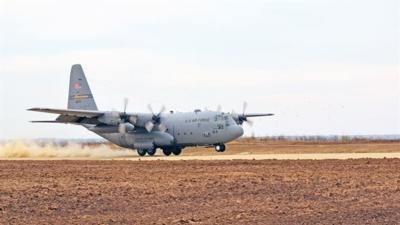Dirt Field Certified For C-130 Operations
The Army and Air Force performed a joint airborne air transportability training exercise on a new flight landing strip at Fort Riley, KS Oct. 27-29. The exercise validated the air strip's capabilities for future operations and replicated conditions Airmen and Soldiers encounter in austere forward operating locations. Construction of this flight landing strip was completed Sept. 13, 2013.

Airmen assigned to the 186th Airlift Squadron, Montana Air National Guard, flew to Manhattan Regional Airport, loaded up a C-130 Hercules and airlifted Soldiers and equipment to the landing strip Oct. 27. Soldiers with the 116th Military Police Company, 97th Military Police Battalion, quickly disembarked with weapons and a Humvee as they simulated rushing into combat.
The Airmen piloted eight more take-offs and landings onto the airstrip, then conducted night airdrop exercises Oct. 28 and 29. According to Army Lt. Col. Joel Potts, from the G3 Future Operations, 1st Infantry Division, going from the concept to the execution of the airstrip, to include the validation process, took about three years. "This air strip was just recently certified," he said. "Now we're validating it by landing C-130s to demonstrate its functional capability. The flight landing strip provides Fort Riley with the capability of conducting joint operations with the Air Force and to transport troops and equipment."
The dirt field is also built to support the standards of large military transport aircraft, such as the C-17 Globemaster III. Capt. Matthew Zahler, the 615th Contingency Operations Support Group Air Mobility liaison officer, said the training simulates what service members have been doing in Afghanistan for the last 10 years. "We're taking Army guys from one place and inserting them onto a dirt (landing zone) where they can go right off the plane into their training field," he said. "In Afghanistan, you have these forward operating bases that are ground locked, and we can't always get supplies to them via the ground, so we have dirt (landing zones) to airdrop stuff in."
Zahler explained dirt strips allow C-130 or C-17 to transport Soldiers and mitigate the threat of improvised explosive device attacks on convoys. "Same thing for supplies," Zahler said. "We can put the things they need, such as ammunition, water, food and gas on the airplane and airdrop them. It's a very quick way to get stuff to our guys in a timely manner when they don't have the option to do convoys."
Soldiers were manifested onto the C-130 Oct. 27 with all their gear, weapons and Humvee. Their role -- to play the part of early arrivals who set up and secure an austere military location. "It tested their manifesting abilities and passenger control," said Army Sgt. 1st Class Michael Hile, the operations sergeant, 116th MP Co., 97th MP Bn. "The Army and Air Force don't do this type of training too often, and especially MPs don't get to go on a C-130 in a Humvee and roll off the back of it ready to go to war."
Hile said he's been in the military for more than 17 years and has flown in a lot of places, including Afghanistan and Iraq, but had never seen a field site, a regular dirt landing strip, in the middle of nowhere. "I've never seen a plane land where we were just ready to roll off and secure an element or just head to war," Hile said. "It's pretty neat."
Air Force Master Sgt. Joshua Archer, the 120th Air Wing air transportation specialist, said this was one of their first joint operations between the Army and the Air Force. "The training is critical because this is what they do in real life," Archer said.
To prepare for the exercise, Archer and his team built up a heavy container delivery system, which allows very large objects, such as Humvees, to be airdropped. "We built all this equipment up to practice dropping," he said. "After unloading the Army folks who would be setting up the location, the night drop was the resupply aspect of it."
The Montana Air National Guard has been flying C-130 aircraft for a little more than a year. Prior to receiving C-130s, the unit flew the F-15 Eagle. "This is our first year in the industry of flying C-130s," Archer said. "We're so new at the game that we're trying to snatch up every training opportunity we can. Our pilots pick up different missions constantly, whether it's moving Army troops from one place to a second location or for the Army to redeploy."
Fort Riley's new flight landing strip was designed to provide the ability to conduct training on a functional airfield capable of being replicated across any theater.
(Image provided by the USAF)
 Airbus Racer Helicopter Demonstrator First Flight Part of Clean Sky 2 Initiative
Airbus Racer Helicopter Demonstrator First Flight Part of Clean Sky 2 Initiative Diamond's Electric DA40 Finds Fans at Dübendorf
Diamond's Electric DA40 Finds Fans at Dübendorf ANN's Daily Aero-Term (04.23.24): Line Up And Wait (LUAW)
ANN's Daily Aero-Term (04.23.24): Line Up And Wait (LUAW) NTSB Final Report: Extra Flugzeugbau GMBH EA300/L
NTSB Final Report: Extra Flugzeugbau GMBH EA300/L Classic Aero-TV: 'Never Give Up' - Advice From Two of FedEx's Female Captains
Classic Aero-TV: 'Never Give Up' - Advice From Two of FedEx's Female Captains



